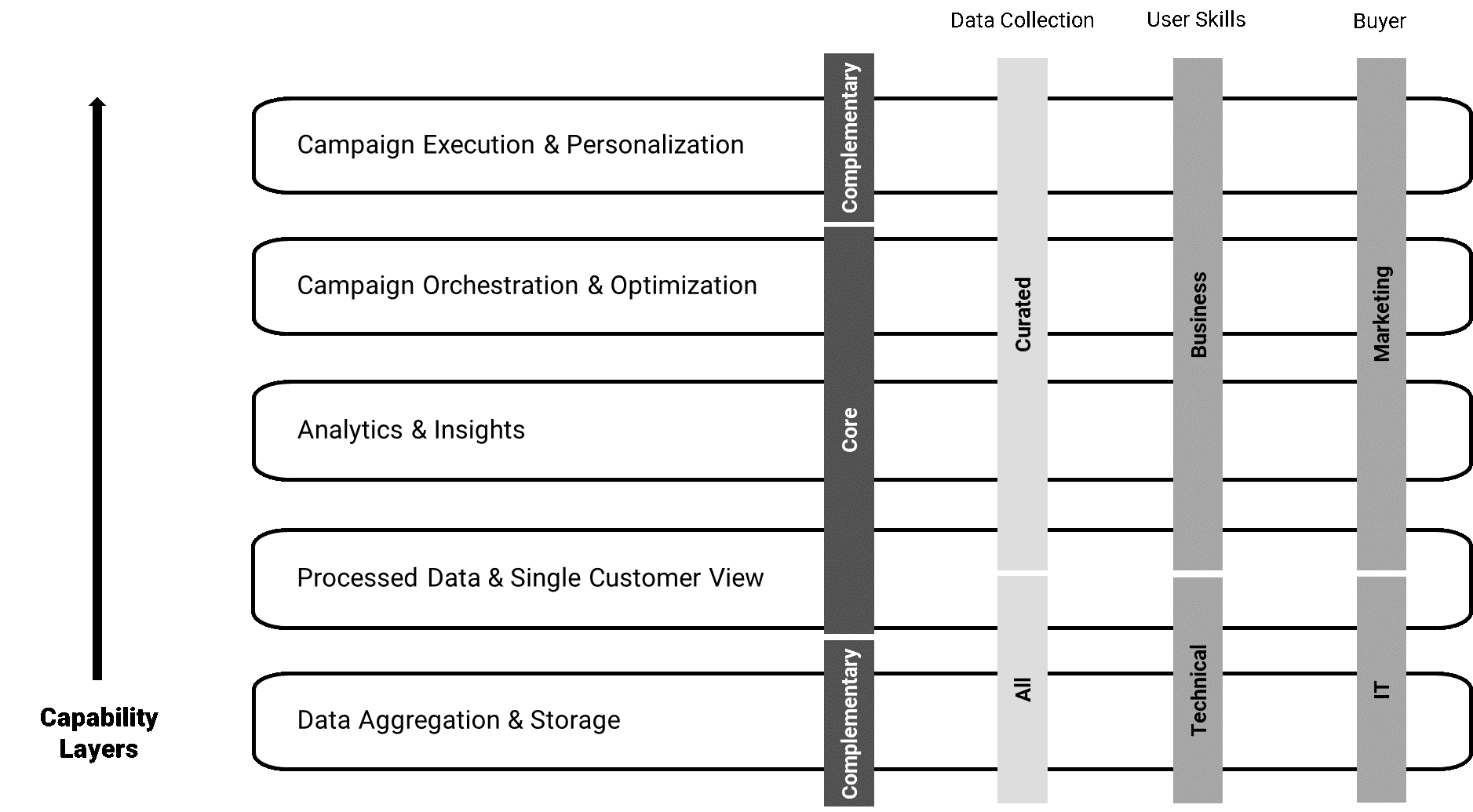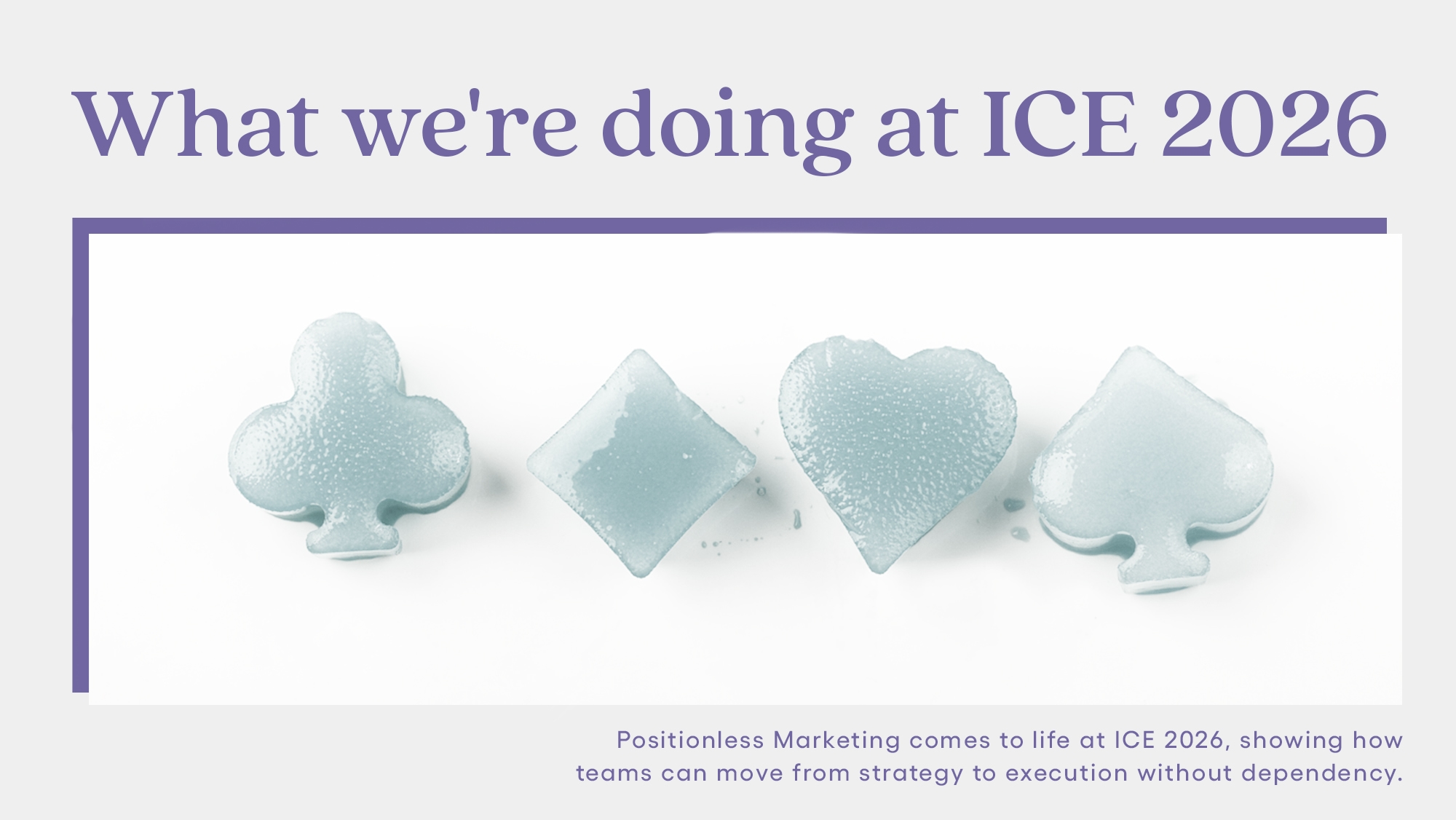
AI and the Retail Marketer’s Future
How AI transforms strategy and processes, driving the adoption of Positionless Marketing
Exclusive Forrester Report on AI in Marketing

2019 is the year of the customer data platform (CDP). Marketing analysts and thought leaders have shared their frustration over disconnected customer data, and requests for CDPs are sprouting up like wildflowers in the spring.
In this blog, we’ll segment the CDP tech stack into five categories to help you filter out the clutter and identify the best solution for your business. Keep in mind, however, that not all organizations need a CDP and not all organizations need the same type of CDP.
in
And away we go…

The first capability layer in the CDP stack provides raw data aggregation and storage by creating and maintaining a centralized repository. This allows you to store all your structured and unstructured customer data, at scale. The data may or may not be curated, meaning you can store it without careful design or the need to know which questions it may need to answer in the future.
The second capability layer in the CDP stack processes the data collected by the first layer and consolidates all data points – first-party data, information systems, data hubs, and sources of marketing interactions – into unified customer profiles. As part of the process, it ensures that the data is both correct and compliant, by enforcing common data standards across the organization.
This layer also allows you to maintain anonymous customer profiles and then, when identification is possible, match or convert these leads to existing customer records.
As a result, businesses can trust infrastructure-focused CDPs to get an accurate, centralized single customer view. This view can then be used to inform decision-making and marketing actions. This layer is the technical foundation for customer-first businesses.
More from Optimove on CDP:Why CDPs Fail: A Tale of Three Unfulfilled Expectations
Customer Data Platform (CDP)
Open the Door for Customer Exploration: Uncovering CDPs’ Irrevocable Powers
The third layer adds strong data analysis capabilities to the first two layers of the CDP stack. However, collecting data and events from various sources and storing them in consumable formats are only part of the picture. This data should also feed machine learning and predictive analytics algorithms that can autonomously surface insights (e.g., next best actions, warnings and opportunities). They also provide an intuitive UI for business users, facilitating access to customer data and insight discovery without the prerequisite need for high technical proficiency.
The data collection and insight generation of the first three layers serves the primary goal of improving customer engagement, loyalty, and lifetime value. This is accomplished by the fourth layer, which adds the critical campaign orchestration and optimization capabilities to the CDP offering. It eliminates data silos and enables marketers to leverage the processed single customer view, analytics and actionable insights generated in the lower layers into customer journeys.
A more advanced orchestration layer equips you with advanced and flexible customer segmentation management and automated prioritization of customer campaigns. It adds support for both pre-scheduled and real-time campaigns, seamless cross-channel customer journey orchestration, and more. Additionally, it loops your marketing channel stats back into the system, using AI to constantly optimize results. Simultaneously, it determines the next best interaction for each customer and maximizes uplift from each communication.
The final layer originated with veteran email service providers (ESPs). It contributes a set of messaging and personalization capabilities to the CDP. Execution and personalization-focused vendors typically automate message blasts and real-time content personalization across one main channel (e.g., email, mobile push, website) or sometimes, multiple channels.
Not all marketers need the same CDP. Embracing a single generic definition prevents companies from selecting the best solution for their business needs.
Defining your specific use cases in advance is critical to successfully selecting and deploying a CDP. Mapping and prioritizing your key use cases lends clarity on why you need a CDP in the first place, the primary business goals it should serve, and which challenges it should address.
Some common use-case examples:
Some capabilities and use cases are considered an essential, core part of the CDP, while other complimentary capabilities are provided by some vendors over their core CDP capabilities, resulting in an upgraded CDP offering.
After mapping your key use cases, use this model to understand which ones are supported by each capability layer in the CDP stack, and make sure that the vendors support each one.
The proliferation of data collected, aggregated, and stored by companies poses new challenges to businesses in terms of resource requirements and the ability to utilize it to inform strategic decisions.
Businesses have impulsively reacted to this data explosion by collecting data in the hopes that one day, they will mine it for useful business cases. A general lack of understanding of how to manage the data, an inability to determine whether data fits its intended operations uses, decision making and planning, and a reluctance to delete redundant or low-quality data have led to a “data hoarding” effect. Businesses are often unaware of what data they have and/or what value it holds, creating a sort of digital wasteland.
This approach is very different from “data curation,” a focused process of turning data from various data sources (structured, semi and non-structured) into unified data sets ready for analytics, using domain experts to guide the process.
But data curation isn’t all about data usability; while data storage costs continue to decrease, certain data sets consume other limited organizational resources. Companies must keep in mind the costs of collecting, storing, cleansing, analyzing, and maintaining unnecessary data, without a strong sense of how they will use that data to answer questions and improve business performance.
Furthermore, not all data sets are created equal. Certain types of data require significantly more effort to transform into useful formats. Before committing the resources to process all available customer data, companies should clarify the relevance and need for each data set. When approaching the all-versus-curated debate, companies need to consider whether the use cases justify the processing of the more complex data sets.
As you go higher in the CDP stack, you should acquire the ability to transition from collecting all data, regardless of its purpose or possible future uses to curating particular data. This involves removing data held merely for the purpose of owning it, so that you are only storing and processing data that allows your business to generate actual business value.
Different solutions are owned and operated by different departments in the organization. The same applies to CDPs. CDPs at different levels of the use case spectrum are typically owned and managed by different teams. Before choosing a vendor, consider who will manage and own the CDP and how this will impact internal processes, whether cross-departmental or within your team.
Related questions to consider are: what skills are required to successfully manage the platform – and do you already have the required knowledge within your team?
Even though the promise of the CDP is to serve as a marketer-friendly and marketer-managed solution, some layers cannot be efficiently and independently managed without a certain level of technological knowledge.
Make sure your team has the skills and human resources required for a successful deployment of the CDP you consider acquiring.
CDPs are complex solutions, and the confusion surrounding them hasn’t made things easier. Companies looking to add a CDP to their marketing stack must be extremely cautious when evaluating vendors. The following diagram should be at the center of these efforts.

By carefully considering the specific capabilities and use cases you are looking to address with a CDP, the people who will be using and managing it, and your approach to collecting data, you can sort through the noise.
Exclusive Forrester Report on AI in Marketing
In this proprietary Forrester report, learn how global marketers use AI and Positionless Marketing to streamline workflows and increase relevance.


Pini co-founded Optimove in 2012 and has led the company, as its CEO, since its inception. With two decades of experience in analytics-driven customer marketing, business consulting and sales, he is the driving force behind Optimove. His passion for innovative and empowering technologies is what keeps Optimove ahead of the curve. He holds an MSc in Industrial Engineering and Management from Tel Aviv University.


